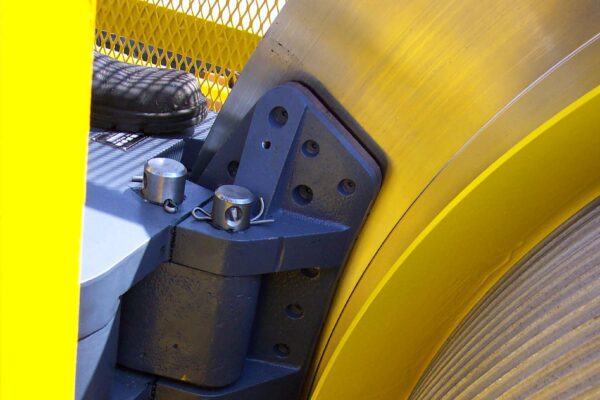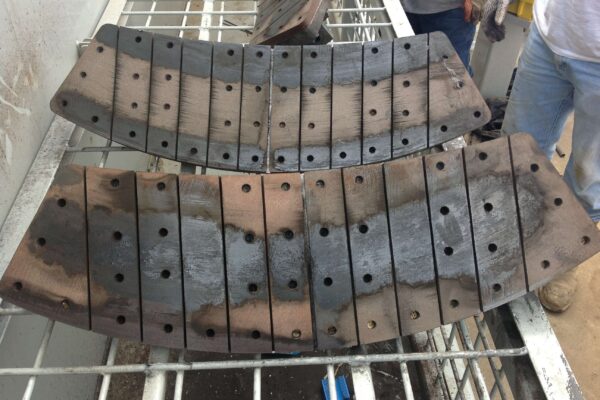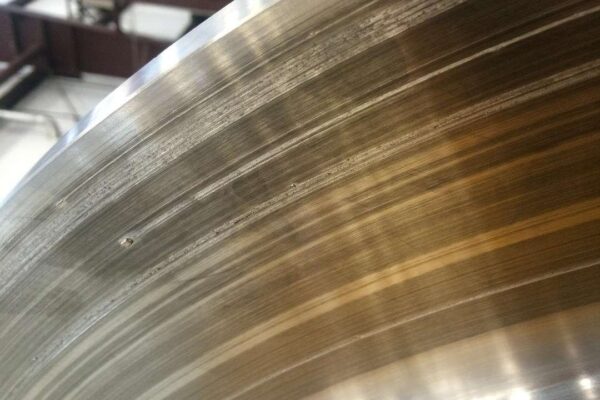Burnishing Industrial Disc Brakes: A Comprehensive Guide

Burnishing a new brake installation
Let’s talk about Burnishing Industrial Disc Brakes in this comprehensive guide. In the world of industrial machinery, we cannot stress enough the significance of both optimal performance and safety in equipment. The brake system stands out as a crucial component that underpins the machinery’s effective functioning.
Take industrial disc brakes as an example; companies employ them in heavy-duty applications such as Conveyors, SAG Mills, Mine Hoists and Lift Bridges. In these contexts, these brakes are essential for ensuring both safety and control.
Moreover, the performance of these brakes can dramatically improve by using a specific technique known as burnishing. Executed with precision, burnishing can amplify the brake torque by up to 50% in some cases. But why is burnishing so pivotal for industrial disc brakes?
In this article, we’ll dive deeper into burnishing industrial disc brakes. We will discuss the steps to perfect this technique and investigate how it can be adapted based on the particular equipment in play. Through this journey, we aim to shed light on the nuances of the technique and offer guidance to those eager to extract peak performance from their braking systems.
Burnishing Industrial Disc Brakes: What is Burnishing?

Burnishing Image showing disc (A) and lining (B)
Burnishing creates a smooth surface on materials, such as brake lining ‘B’ above, by rubbing. In industrial brakes, we recognize burnishing as the break-in process for new friction linings, typically brake pads or shoes.
This method generates controlled and gradual friction. It not only smoothens the peaks and valleys between materials (A and B) but also eliminates contaminants or residues on the brake disc and pads. Thus, it ensures better contact. Thanks to this improved frictional performance, users will notice a significant increase in brake torque.
Burnishing Industrial Disc Brakes: Importance of Burnishing
Industrial brakes play a crucial role in a wide range of applications. Whether we’re talking about Overland Conveyors, Mine Hoists, Crane Hoists, or Lift Bridges, their safety and effectiveness rely heavily on the efficient operation of their braking systems.
Additionally, the process of burnishing significantly improves the efficacy of these brakes. When done correctly, burnishing can boost brake torque by up to 50%. In this article, we’ll explore the nuances of burnishing industrial disc brakes and highlight its importance across different equipment types.
Burnishing Industrial Disc Brakes: Introduction
The term “industrial brakes” may sound broad, yet it covers a wide range of essential mechanisms crucial to various sectors. Specifically, these brakes work to stop or manage the movement of large rotating power transmission equipment.
For instance, consider the massive Mine Hoists or the sprawling overland mining Conveyors. Their safety and efficiency directly depend on the impeccable performance of their brakes.

Figure 2 Industrial Disc Brakes during dynamometer testing
Burnishing Industrial Disc Brakes: The What and Why
Burnishing is a process where new friction materials, like brake pads, are conditioned to maximize their performance. By creating a series of controlled stops, friction materials get evenly spread across the disc’s surface, smoothing out any imperfections.
Why is this vital? Burnishing:
Enhances Performance: It prepares the brake for its correct torque value.
Longevity: A well-burnished brake reduces the risk of glazing, which in turn extends the life of the linings.
Safety: By ensuring the brake pads and discs have optimal contact, the likelihood of brake failure diminishes
No Surprises: The brake is installed as per the original engineering and stopping or holding calculations.
The most noteworthy outcome, however, is the potential to increase brake torque by up to 50%. Such an augmentation can be the difference between operational success and a severe reduction in braking torque, especially in heavy-duty applications.
Burnishing Industrial Disc Brakes: Tailoring Burnishing to Equipment Type
Given the vast array of equipment that leverages industrial brakes, it’s clear that a one-size-fits-all approach to burnishing won’t suffice. However, there are many similarities in the brake burnishing process.

Figure 3 Mine Hoist during commissioning with Johnson DS Brake
Mine Hoists, Cranes, Steel Mill & Ladle Cranes, Oil Rigs, Drive Systems, and Bulk Material Handling Ship loaders are all essentially known as hoists. Due to their frequent and sudden starts and stops, they need a robust brake system that can withstand considerable wear and tear.
To prepare these systems optimally, we burnish them, a process that replicates a series of stops to reflect real-world operating conditions. For the best burnishing results, you should drive the hoist motor through the brakes while intentionally lowering the brakes’ torque value.
It’s best to conduct this in stages, slowly increasing the disc temperature. Throughout this process, it’s crucial to monitor the motor current. You should notice a consistent rise, peaking at about 20% over the initial value before leveling off. Once this level is maintained, it indicates that the brakes are adequately burnished.
Overland Mining Conveyors:
These systems play a crucial role in transporting extracted minerals. Therefore, they must have accurately controlled brakes. Burnishing, in this scenario, emphasizes gradual and controlled stops. Traditionally, operators achieve this by making several stops with an unloaded belt. Then, they often increase the amount of material on the belt by 25% with each subsequent stop. During standard commissioning, operators make between 3 to 5 stops per hour.

Figure 4 Multiple Drive Overland Conveyor during commissioning
SAG and BALL Mills:
The SAG/BALL Mill is a massive engineering marvel, with its impressive, large disc flange (up to 13.4m [44′]). When burnishing the brakes on a SAG Mill, users typically utilize a Variable Frequency Drive (VFD). Additionally, the brakes employ proportional pressure control. Much like the process with a mine hoist, the brakes undergo burnishing. However, it’s worth noting that the large disc flange might need more time to reach the desired temperature.

Figure 5 A Large BALL Mill During Commissioning
Optimal Brake Burnishing Results:
For optimal results, it’s recommended to adopt a three-stage burnishing process, allowing for a cooling break between each stage. The whole burnishing process for a SAG / BALL Mill usually takes a total of 30 to 45 minutes. During burnishing, the brakes are set to about 50% torque using the proportional pressure control valve. Afterward, the VFD measures the actual torque, which can impressively reach over 22 million Nm, or 16.2 million lb.ft., of brake torque.
Marine Propulsion: Initiating with a basic understanding, marine propulsion brake burnishing stands out as an essential procedure in the maritime sector. This process primarily revolves around the proper conditioning of brake components to optimize performance.
For maneuvering brakes as in figure 6, the procedure is very straight forward as the brake merely needs to be used and burnishing occurs after several consecutive applications.

Figure 6 Pneumatic marine brakes for maneuvering
Ski Lifts: The burnishing process for brake systems on ski lifts follows a particular sequence. Initially, the brake system stops multiple times without any load. After this, to enhance burnishing, we simulate the load of passengers by adding the average weight of a person to the ski-lift chairs.
We continue this process, gradually loading up to half the chairs. Once we achieve this load, we carry out several stops as part of the burnishing procedure.
The above examples illustrate that while the foundational principles of burnishing remain consistent, the nuances change slightly based on equipment specifications.
Burnishing Industrial Disc Brakes: The Process
While burnishing steps might vary slightly depending on the equipment, the general approach is usually the same and involves monitoring temperature, motor speed, motor current, and brake pad pressure:
- Setup: Ensure that the brake system is correctly installed and calibrated as per the certified drawing from the manufacturer.
- Gradual Warm-up: Run the equipment to bring the brake disc to a moderate temperature.
- Staged Burnishing Cycles: Implement a series of stops, increasing in intensity. This will create an even spread of friction materials or transfer layer. As an alternative method, constant speed and pressure can be applied until the motor current reaches the correct amperage value. With each stage of burnishing a temperature should be achieved. We recommend three stages, 93°C [200°F], 150°C [300°F] and to a maximum of 200°C [400°F]. The absolute maximum for burnishing should be 260°C [500°F].
- Cool Down: At each stage in (3) above there should be a cool down period of 10 to 15 minutes up to the maximum temperature. Once the maximum temperature has been reached burnishing should be complete and the disc should be allowed to cool down back to ambient temperature.
In specific industrial brake system burnishing scenarios, especially in situation #3, we can actively apply the brakes at a reduced torque. Moreover, we can maintain the drive system at a constant speed and simultaneously monitor the motor current. This approach proves to be highly advantageous for burnishing.
Benefits once burnishing is successfully conducted:
Peak Performance: The industrial brake system operates at its maximum potential.
Reduced Maintenance: With an even spread of friction material and reduced risk of glazing, brakes demand less frequent maintenance.
Safety Assurance: A well-burnished brake minimizes the potential for failures or mishaps.
What Brake Burnishing Problems can be encountered?

Figure 7 Brake Linings contaminated with grease

Figure 8 Metal Forming Surface Sphere / Ball on disc surface during burnishing
- Over Heated Disc: due to improperly mounted brakes creating poor contact and dragging linings / pads
- Disc Warp or Discoloration: due to disc over heating
- Balling up metal on disc Surface: can be caused by too soft a disc material (see figure 8)
- Not achieving brake torque: can be caused by grease or other contaminants on the brake shoes (see figure 7)
- Linings Dragging on the Disc: can be caused by incorrectly mounted brakes
- Incorrect surface speed: an adequate PV (Pressure * Velocity) value is needed for burnishing
- Pad Pressure: can be too high or too low resulting in poor burnishing
- Aggressive Pads: sintered pads can be very hard on discs versus organic lining material.
Conclusion
Burnishing stands as a vital step in maintaining and enhancing the performance of industrial disc or drum brakes. From the industrial brake systems in Conveyors, SAG Mills, and Cranes to those in Mine Hoists and Lift Bridges, the burnishing technique remains consistent. Not only does it ensure safety and longevity, but it also boosts brake torque by an impressive 50%. Clearly, no industry can afford to ignore such a crucial safety investment.
Contact us today for any application or questions you have!
Leave a reply
